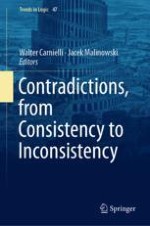2018 | OriginalPaper | Buchkapitel
Interpretation and Truth in Set Theory
verfasst von : Rodrigo A. Freire
Erschienen in: Contradictions, from Consistency to Inconsistency
Aktivieren Sie unsere intelligente Suche, um passende Fachinhalte oder Patente zu finden.
Wählen Sie Textabschnitte aus um mit Künstlicher Intelligenz passenden Patente zu finden. powered by
Markieren Sie Textabschnitte, um KI-gestützt weitere passende Inhalte zu finden. powered by
